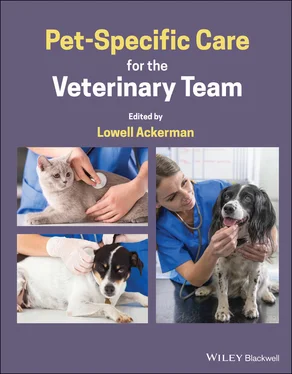3.3.4 More on Penetrance and Expressivity
Genetic testing allows us to detect discrete genetic variants for diseases and traits, and yet in real life, the manifestations sometimes appear more like shades of gray than black and white (see 3.4Predicting and Eliminating Disease Traits). If a pet has a genetic variant detected, shouldn't that mean that the clinical result is a foregone conclusion? Like much of medicine, the answer is both yes and no. Here's why.
To understand the situation, we need to go back to a basic tenet of genetics – genetic mutations/variants don't cause disease; they code for proteins that may not be fully functional and it is this dysfunction that is interpreted as disease (see 3.1Genetic Basics). The body tends to have a lot of redundant systems, so there may be other genes, epigenetic markers, modifiers, suppressors, and environmental factors that all impact the clinical manifestations in the living patient.
Clinical diagnosis also requires that we be able to clinically differentiate between the “normal” gene and the “variant” gene in all cases within a population of animals, and this is referred to as penetrance. Penetrance can be defined as the percentage of individuals in a population with a given genetic variant (genotype) that fully display the clinical manifestations (phenotype), and this is rarely 100%. Because of this, many conditions are described as having incomplete penetrance and this explains why we can't fully predict the clinical situation, even with sophisticated genetic screening. Some disorders may have full (100%) penetrance, but many more do not.
In contradistinction to penetrance, which looks at genetic manifestations on a population level, expressivity measures the extent to which a genetic variant (genotype) actually expresses the so‐called clinical abnormality (phenotype) on an individual level. There can be different degrees of expression of identical variants in different individuals based on other genes present or environmental factors. Because of this, we might describe that there could be variable expressivity for this variant in different individuals.
These features of penetrance and expressivity make genetic counseling as much an art as a science, even given the certainty of genetic screening. It is also a great reason why genetic testing favors the nuanced interpretation by well‐trained veterinary teams to properly counsel pet owners on the benefits of pet‐specific care and the goal of helping pets live long, healthy, and happy lives.
As if penetrance and expressivity didn't add enough variability to the equation, it's important to realize that there may be diseases, phenes, and traits caused by the effects of more than one gene. Some loci have a variety of different alleles that could participate in a gene pair. Nowhere is this more apparent than in coat coloration ( Table 3.3.1). Epistasis is when the action of one gene depends on the action of another gene. Epistasis is wonderfully illustrated by the coat colors possible with different combinations of alleles from different loci. All breeds have all the loci mentioned, but they do not necessarily have all the possible alleles mentioned. Even within a given locus, some alleles are dominant over others.
Table 3.3.1 The genetics of coat color
| Locus and allele |
Effect |
| Agouti |
|
| A |
Solid color |
| Ay |
Fawn/sable |
| Aw |
Gray/wolf |
| as |
Saddle |
| at |
Bicolor (tan points) |
| a |
Recessive black |
| Black |
|
| B |
Black |
| b |
Liver |
| Color |
|
| C |
Color factor |
| CC |
Full color |
| cch |
Chinchilla |
| c e |
Extreme dilution |
| cd |
White with dark eyes |
| cb |
Blue eyes |
| c |
Albinism |
| Dilution |
|
| D |
No dilution |
| d |
Dilution (e.g., blue Doberman) |
| Extension |
|
| Em |
Black mask |
| E |
Normal extension |
| e |
Nonextension (yellow) |
| Graying |
|
| G |
Born black, turns blue |
| g |
Born black, stays black |
| Intensity |
|
| INT |
Lightest tan |
| intm |
Intermediate tan |
| int |
Darkest tan |
| Solid |
|
| K |
Solid color in pigmented areas |
| Br |
Brindle |
| Y |
Allows yellow pigment to show |
| Merle |
|
| M |
Merle |
| m |
Nonmerle |
| Spotting |
|
| S |
Solid color |
| si |
Irish spotting |
| sp |
Piebald |
| sw |
Extreme white piebald |
| S‐extension |
|
| Se |
Black mask |
| sese |
No black mask |
| Ticking |
|
| T |
Ticking |
| t |
Nonticking |
Although many medical conditions are the result of gene mutations that have passed from generation to generation, evidence is mounting that the environment can not only have an impact on personal health but can also be conserved in the genes. These environmental “shocks” seem to be capable of leaving an imprint on the genetic material in eggs and sperm, which can pass along new traits in a single generation.
The epigenome sits above the DNA sequence and provides a second layer of information, regulating several genomic functions, including when and where genes are turned on or off. New studies have shown that so‐called epigenetic marks are associated with genes, providing instructions such as telling them to switch on or off. These marks are normal and allow cells to differentiate, but if the marks do not work properly because of an environmental stressor, cancer or cell death might result, and, worst of all, could be transmitted to descendants. So, if some stressor such as a rich diet activates an epigenetic mark, which in turn modifies histones or adds methyl groups to DNA strands, it could result in disease or susceptibility to disease that not only affects the individual but can be passed on to future generations. This epigenetic influence may not even occur equally across both alleles, in some instances depending on genotype and in other instances depending on from which parent the allele was inherited. Nutrition is likely a major factor in epigenetics, and technological advances will likely lead to the identification of nutrient‐responsive genes and biological pathways, important nutrient–gene interactions, and genomic biomarkers of disease [1].
While perhaps not as well known and discussed as the genome, the epigenome is believed to be much larger and more complicated than the genome of 20 000 or so genes. Medications are even available now that exert their effects through epigenetic marks. These developments are bound to assume more significance in the years ahead.
3.3.7 Genetics and Cancer
There is no doubt that many cancers have genetic associations [2] but there is still much to learn about the genetics of cancer. Solid evidence exists that some cancers, such as those associated with dermatofibrosis, have a genetic basis, and a DNA test can even be used for that particular disorder. Pugs are predisposed to viral pigmented plaques, associated with papillomavirus. Lymphoproliferative diseases also appear to have well‐defined heritable risk factors in at least some breeds. In many other instances, definite breed predispositions exist, but in many cases a definitive genetic basis is lacking. In other cases, epigenetics and environmental causes may coincide with genetics to promote cancer. For example, the incidence of transitional cell carcinoma (TCC) has been steadily increasing in dogs over the years, and the risk of Scottish terriers developing TCC is approximately 18 times the risk of mixed‐breed dogs [3]. Further studies have suggested that this breed‐associated risk may be due to differences in pathways that activate or detoxify carcinogens, and exposure to lawns or gardens treated with phenoxy herbicides could potentially be associated with the increased risk of TCC in Scottish terriers.
Читать дальше












